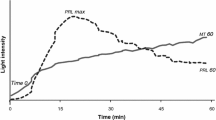Summary
Pigment of tail-fin melanophores in periodic albino Xenopus laevis tadpoles is dispersed in response to darkness and to α-MSH in a manner similar to wild-type melanophores. However, periodic albino tadpoles lack the response to different background conditions and the melatonin-induced aggregation in darkness. The tyrosinase activity in cells of the latter type tadpoles is weak compared to the wild-type cells. Ultrastructural examination of melanophores from periodic albino mutants and cells from wild-type tadpoles shows similar organelles at corresponding sites. A morphological difference can be observed in the fine structure of the melanosomes, which in albinos resembles an earlier stage of development. It is postulated that periodic albino Xenopus laevis possess the cellular mechanism to disperse pigment in the melanophores, but that under physiological conditions the release of α-MSH appears to be absent or scarce.
Similar content being viewed by others
References
Bluemink JG, Hoperskaya OA (1975) Ultrastructural evidence for the absence of premelanosomes in eggs of the albino mutant (ap) of Xenopus laevis. Wilhelm Roux's Arch 177:75–79
Bowers RR, Carver VH (1978) Ultrastructural study of the cutaneous pigment cells of wild-type and albinistic bullfrogs, Rana catesbeiana. J Ultrastr Res 64:388–397
Burgers ACJ, Oordt GJ van (1962) Regulation of pigment migration in the amphibian melanophore. Gen Comp Endocrinol Suppl 1, 99–109
Charlton HM (1966) The pineal gland and color change in Xenopus laevis Daudin. Gen Comp Endocrinol 7:384–397
Eberle AN, Kriwaczek VM, Schwyzer R (1979) Studies on tyrosinase stimulation, binding and degradation of α-MSH interacting with non-synchronized mouse melanoma cells in culture. In: Gross E, Meienhofer J (eds) Peptides: structure and function. Pierce Chem Comp, p 1033–1036
Eys GJJM van (1980) Structural changes in the pars intermedia of the cichlid teleost Sarotherodon mossambicus as a result of background adaptation and illumination. I. The MSH-producing cells. Cell Tissue Res 208:99–110
Graan PNE de, Eberle AN (1980) Irreversible stimulation of Xenopus melanophores by photoaffinity labelling with p-azidophenylalanine13-α-melanotropin. FEBS Lett 116:111–115
Hadley ME, Quevedo WC (1967) The role of epidermal melanocytes in adaptive color changes in amphibians. In: Montagna W, Hu F (eds) Advances in biology of skin 8. Pergamon Press Ltd, Oxford, p 337–359
Hoperskaya OA (1975) The development of animals homozygous for a mutation causing periodic albinism (ap) in Xenopus laevis. J Embr Exp Morphol 34:253–264
Hoperskaya OA (1978) Melanin synthesis activation dependent on inductive influences. Wilhelm Roux's Arch 184:15–28
Lee TH, Lee MS (1971) Studies on MSH-induced melanogenesis: Effect of longterm administration of MSH on melanin content and tyrosinase activity. Endocrinol 88:155–164
MacMillan GJ (1979) An analysis of pigment cell development in the periodic albino mutant of Xenopus. J Embr Exp Morphol 52:165–170
Nieuwkoop PD, Faber J (1956) Normal table of Xenopus laevis (Daudin). A systematic and chronological survey of the development from fertilized eggs till the end of metamorphosis. NorthHolland Publishing Company, Amsterdam
Oshima K, Gorbman A (1969) Evidence for a doubly innervated secretory unit in the anuran pars intermedia. I. Electronphysiologic studies. Gen Comp Endocrinol 13:98–107
Seldenrijk R, Berendsen W, Hup DRW, Veerdonk FCG van de (1980) The morphology of cultured melanophores from tadpoles of Xenopus laevis: Scanning electron microscopical observations. Cell Tissue Res 211:179–189
Seldenrijk R, Graan PNE de, Steensel N van, Veerdonk FCG van de (submitted for publication) The effect of Ca2+ on the response of tail-fin melanophores of Xenopus laevis to darkness, light and melatonin.
Seldenrijk R, Hup DRW, Graan PNE de, Veerdonk FCG van de (1979) Morphological and physiological aspects of melanophores in primary culture from tadpoles of Xenopus laevis. Cell Tissue Res 198:397–409
Tompkins R (1977) Grafting analysis of the periodic albino mutant of Xenopus laevis. Dev Biol 57:460–464
Wyllie AH, Robertis EM de (1976) High tyrosinase activity in albino Xenopus laevis oocytes. J Embr Exp Morphol 36:555–559
Author information
Authors and Affiliations
Rights and permissions
About this article
Cite this article
Seldenrijk, R., Huijsman, K.G.H., Heussen, A.M.A. et al. A comparative ultrastructural and physiological study on melanophores of wild-type and periodic albino mutants of Xenopus laevis . Cell Tissue Res. 222, 1–9 (1982). https://doi.org/10.1007/BF00218284
Accepted:
Issue Date:
DOI: https://doi.org/10.1007/BF00218284




